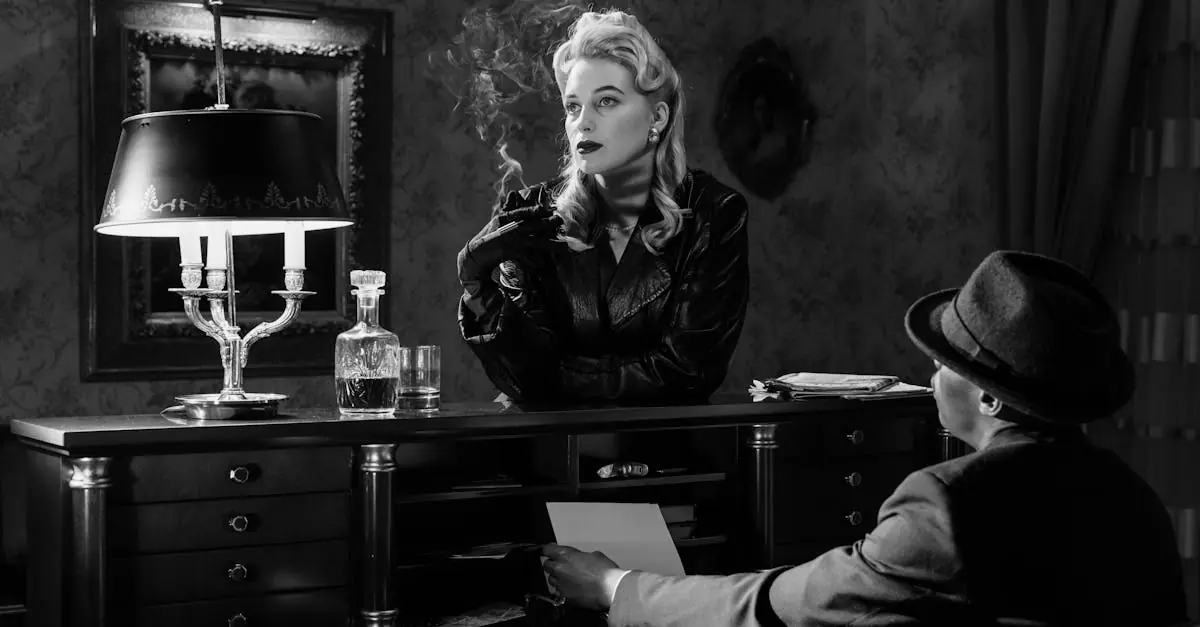Table of Contents
ToggleIn a world where every movie is dissected by critics armed with popcorn and a sharp pen, the “movie critic plot” emerges as a fascinating lens through which to view cinema. It’s a wild ride that blends humor, drama, and a dash of absurdity, all while navigating the highs and lows of film critique. Imagine a universe where critics don’t just sit in dark theaters but become characters in their own stories, battling over the best and worst of Hollywood.
Overview of The Movie Critic Plot
The movie critic plot presents a narrative technique where critics emerge as central characters, actively influencing the course of events. In this context, critics delve into their unique experiences with cinema, providing insight into the film industry’s intricacies. Engaging conflicts arise as these characters navigate their perceptions of various cinematic works.
Critics often confront challenges that reflect broader societal issues within the film industry. These conflicts highlight the balance between personal taste and critical responsibility, showcasing how individual reviews impact audience reception. Dramatic moments unfold when characters engage in debates, analyzing films through a humorous lens.
Comedy plays a significant role in this narrative form. Characters experience humorous misadventures while grappling with their professional opinions, allowing for a relatable exploration of film criticism. Audiences resonate with the trials and triumphs faced by critics, fostering an understanding of the complexities in analyzing cinema.
Furthermore, the emotional stakes heighten when critics encounter films that resonate deeply with them. Personal connections to specific genres or styles ground the narrative, making it impactful. These moments offer layers to the plot, enriching the characters’ journeys and their interactions with the cinematic world.
Ultimately, the movie critic plot serves as a lens through which viewers can appreciate both the art of filmmaking and the critical discourse surrounding it. This fresh storytelling approach encourages reflection on the subjectivity of criticism, enriching the overall cinematic experience for audiences everywhere.
Key Characters
The movie critic plot features a range of dynamic characters, each contributing to the narrative’s depth. Critics navigate their unique journeys while embodying various film industry perspectives.
Protagonist Analysis
Critics often serve as protagonists in this narrative structure. They face personal challenges while balancing their professional insights with their emotional responses to films. Character development reveals their growth, as they grapple with their biases and confront the societal implications of their critiques. The protagonist’s journey illustrates how personal experiences shape opinions, demonstrating the impact of emotional investment in cinema. Overall, these critics reflect diverse viewpoints that resonate with audiences, revealing the intricacies of film appreciation.
Antagonist Role
Antagonists in the movie critic plot typically challenge the protagonists’ perspectives. They may represent alternative viewpoints, forcing critics to defend their tastes and judgments. Conflicts often arise from competing ideals about cinema, highlighting issues such as authenticity and commercialism. Antagonists can be other critics, filmmakers, or general audiences who question the protagonist’s authority on film. Through these tensions, the narrative delves into broader themes, such as the role of criticism in shaping audience perceptions and creating dialogue within the industry.
Themes Explored in The Movie Critic Plot
The movie critic plot dives deep into several thought-provoking themes.
Critique of Society
Critics within the plot often serve as mirrors reflecting societal issues. They tackle themes such as cultural representation, class struggles, and gender dynamics in film. Personal biases come into play, revealing how critics influence public perception. Characters face challenges that resonate beyond cinema, highlighting the impact of art on contemporary society. These narratives encourage audiences to rethink prevailing norms and question the status quo. In turn, critiques unfold in humorous yet poignant ways, offering insight into societal complexities while engaging viewers.
The Nature of Art and Film
Artistic expression takes center stage in the movie critic plot. Critics explore the essence of creativity and its connection to commercial viability. Characters often grapple with the tension between artistic integrity and market demands. Perspectives differ as some defenders of independent films clash with supporters of mainstream cinema. These conflicts highlight broader questions surrounding authenticity and viewer engagement. Critics evolve as they encounter groundbreaking works, reshaping their understanding of what constitutes true art. Through their journeys, the plot illustrates the subjective nature of film and the diverse interpretations that arise from it.
Cinematic Techniques Used
Cinematic techniques in the movie critic plot enhance storytelling and deepen audience engagement. These elements provide a rich framework for the narrative.
Visual Storytelling
Visual storytelling conveys emotions and themes through imagery. Cinematography captures subtle nuances, illustrating characters’ inner conflicts while enhancing their critiques. Distinct color palettes emphasize mood shifts, guiding viewers’ emotional responses. Close-up shots reveal critics’ reactions, inviting audiences to share in their experiences. Dynamic camera movements can heighten tension during pivotal scenes, reinforcing the characters’ stakes in the cinematic world. Symbolic visuals, such as mirrors or screens, represent the critics’ reflections on society, creating layers of meaning. Each visual choice serves to reinforce the central theme of film criticism and its complexities.
Sound Design
Sound design plays a crucial role in the movie critic plot. The use of dialogue carries significant weight, showcasing characters’ intellect and perspective. Background scores enhance emotional resonance, underscoring moments of tension and humor. Ambient sounds create immersive environments, allowing viewers to feel the cinematic world’s vibrancy. Creative sound effects can highlight humorous misadventures, adding depth to comedic scenarios. Juxtaposition of sound can reflect the contrast between critical acclaim and commercial pressure. Together, these auditory elements shape the audience’s experience, amplifying the impact of the critiques and the narrative’s emotional core.
Audience Reception and Impact
Audience reception plays a critical role in the success of the movie critic plot. Viewers often resonate with the critics’ personal journeys, leading to increased empathy and engagement with the narrative. When characters navigate their biases, audiences see reflections of themselves, enhancing their understanding of film critique.
Impact on public discourse showcases how critics influence perceptions of cinematic works. Critics’ reviews can steer audience opinions, often determining a film’s box office performance. Reactions on social media amplify these effects, where discussions around films can ignite passionate debates about cinema’s cultural relevance.
Critical acclaim also plays a significant role in shaping narrative arcs within the movie critic plot. Positive reviews usually lead to heightened interest, while negative critiques can discourage viewership. Notably, awards and accolades serve as indicators of success, further impacting audiences’ choices.
Conversely, audience reception can reshape the critics’ narrative trajectory. Feedback from viewers influences critics’ perspectives and encourages them to reassess their opinions. Critics learn to balance personal viewpoints with public sentiment, fostering a more inclusive dialogue about film.
Film festivals often showcase how the movie critic plot finds diverse interpretations. These events allow critics to directly engage with audiences, facilitating discussions that enrich the viewing experience. Such dialogues foster connections between art and spectators, ensuring that critiques evolve with cultural shifts.
The relationship between audience reception and critical impact creates a cyclical effect. Films challenge societal norms while critics engage with these themes through their unique lenses. This dynamic enriches the cinematic landscape, creating opportunities for audiences to rethink their relationships with film and critique.
The movie critic plot offers a compelling exploration of the intersection between film criticism and personal narrative. By placing critics at the heart of the story, it invites audiences to engage with the complexities of cinematic evaluation. This unique perspective enriches the viewing experience and encourages deeper reflections on the nature of art and critique.
As critics navigate their own biases and societal issues, they reveal the multifaceted relationship between cinema and its audience. The blend of humor and emotional depth in these narratives resonates with viewers, making the journey through the world of film both entertaining and thought-provoking. Ultimately, the movie critic plot not only entertains but also fosters a richer understanding of the evolving landscape of film and criticism.




